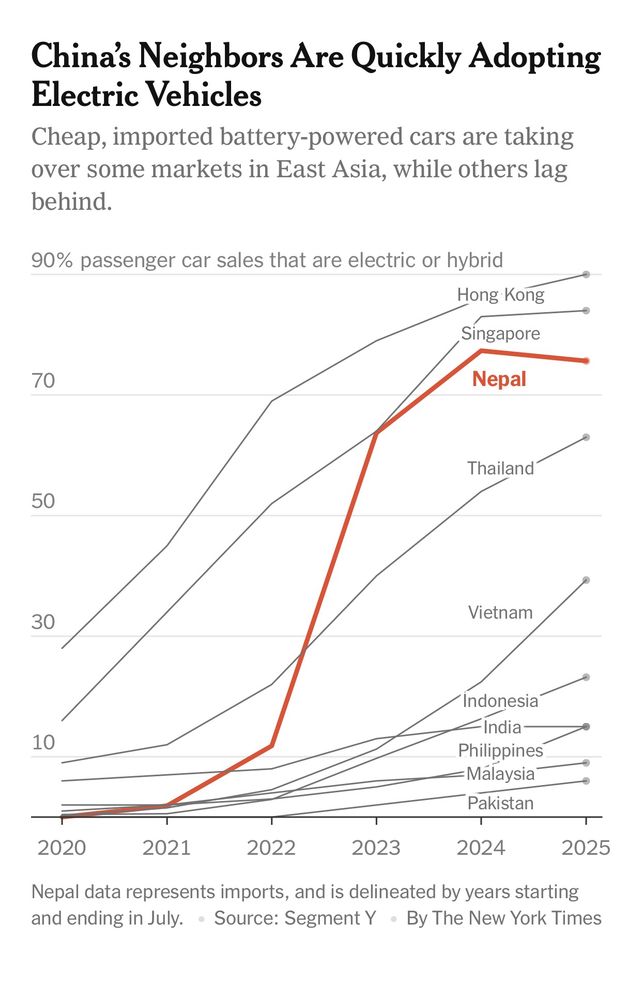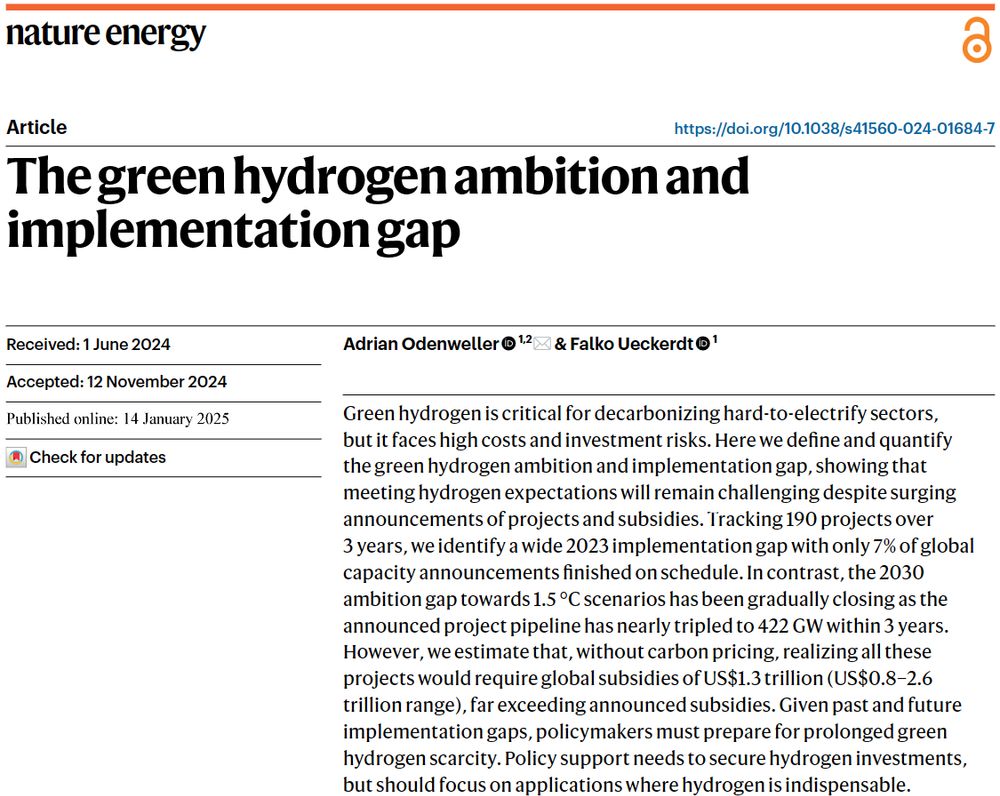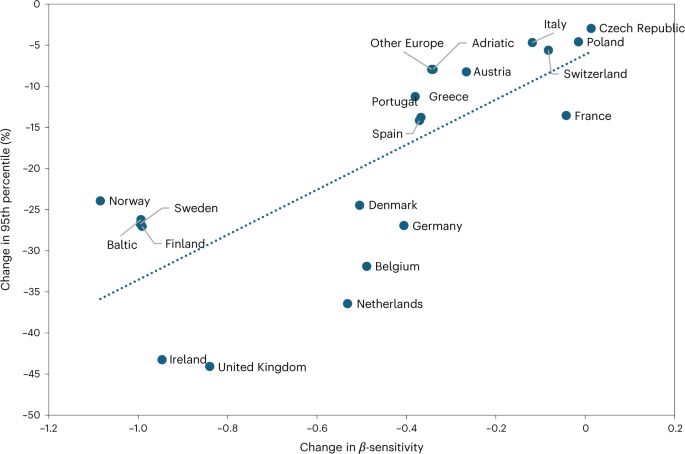Study on lowest still achievable global warming by @climateanalytics.org featuring our integrated assessment model REMIND from @pik-potsdam.bsky.social and my colleagues Fabrice Lécuyer, Chris Gong and @gunnarenergyclima.bsky.social.
06.11.2025 19:33 — 👍 1 🔁 0 💬 0 📌 0

As coal fades, Australia looks to realize dream of 100% renewable…
The country’s grid operator says shifting from coal to clean power is not only possible but inevitable. The work there could provide a road map for other…
Australia's grid operator has a clear line of sight to 100% renewables. There's nothing unknown or exotic required.
It'll be fun when the first large/major economies start hitting the goal. Too bad the US is likely to be at the rear of the pack.
06.10.2025 17:43 — 👍 741 🔁 189 💬 25 📌 15

r/ChatGPTPro
u/vurto • 28d
If ChatGPT is not consistently dependable, how are we suppose to use it for actual work?
Discussion
It's behavior and results can randomly change due to some OpenAl tweaking that's opaque.
On some days it can't even keep track of a fresh chat, it can't do calculations, it can't sort through a chat to extract relevant information, and when it's suppose to refer to source material in a PDF, it doesn't.
All because OpenAl trained it for fluency and basically to simulate whatever it can for user satisfaction.
I can use it for general chats, philosophical stuff, therapy, but nothing serious. I'm pro Al, but I approach it with skepticism knowing it's undependable (as I do with anything I read).
And prompts can be interpreted/executed differently across users' own interaction with their Als so it's not truly scalable.
How does the business world / leaders expect staff to adopt Al if it's not consistently dependable? It doesn't even calculate like a calculator. If the internet start claiming 2+2=5, that's what it'll answer with.
I'd use it for hobbies and pet projects but I can't imagine using it for anything "mission critical".
You're so close
05.08.2025 04:36 — 👍 9375 🔁 1910 💬 188 📌 225

Staggering figures.
Source: www.nytimes.com/2025/07/28/b...
“Nepal, The Country Where 76% of Cars Sold Are Electric”
02.08.2025 22:17 — 👍 185 🔁 67 💬 6 📌 7

This graph from @fschreyer.bsky.social and @pik-potsdam.bsky.social colleagues illustrates the dilemma nicely "LeastCost" path involved scaling up CCS faster than historical precedents. Avoiding fossil-CDR ("FosFree") means doing same for e-fuels.
www.researchsquare.com/article/rs-5...
15.06.2025 11:49 — 👍 5 🔁 2 💬 2 📌 0

#Ariadne-Forscher @gunnarenergyclima.bsky.social vom @pik-potsdam.bsky.social zu den notwendigen #Investitionen für eine erfolgreiche #Energiewende, die Deutschlands #Wettbewerbsfähigkeit sichert.
Mehr dazu im neuen #Szenarienreport2025 vom Kopernikus-Projekt Ariadne 👉 buff.ly/SSTJHC2
10.03.2025 10:00 — 👍 10 🔁 4 💬 0 📌 0

Jetzt erst recht: #StandWithUkraine!
Trump wendet sich von der Ukraine ab – wir nicht! Setze mit Tausenden ein Zeichen der Solidarität und Unterstützung. Gemeinsam für Freiheit, Demokratie & ein starkes Europa!
🗓️ Sonntag, 9. März, 17 Uhr
📍 Brandenburger Tor, Berlin
07.03.2025 13:23 — 👍 245 🔁 73 💬 3 📌 5

#Ariadne-Report kalkuliert Pfade zur #Klimaneutralität 2045 in Deutschland: Der Zusatzaufwand der #Transformation lässt sich durch kosteneffizienten #Klimaschutz je nach Szenario auf jahresdurchschnittlich 16 - 26 Mrd. Euro bis 2045 begrenzen, 0,4 - 0,7 Prozent der heutigen #Wirtschaftsleistung.
06.03.2025 08:02 — 👍 27 🔁 13 💬 4 📌 2

Investitionen für #Klimaneutralität 2045 in 🇩🇪 werden zum Großteil durch Minderausgaben für Gas/Öl/Kohle ausgeglichen. Zusatzaufwand bei kosteneffizienter Politik 0,4-0,7% des aktuellen BIP. @ariadneprojekt.bsky.social Ariadne-Szenarienreport mit Beteiligung PIK.
👇
www.pik-potsdam.de/de/aktuelles...
06.03.2025 09:42 — 👍 13 🔁 10 💬 0 📌 2
YouTube video by Potsdam Institute for Climate Impact Research PIK
Klimaneutralität 2045: Ariadne-Szenarienreport kalkuliert kosteneffiziente Pfade für Deutschland
Viele Monate haben #Ariadne-Forschende aus sechs am @ariadneprojekt.bsky.social beteiligten Instituten an dem neuen #Szenarienreport2025 gearbeitet. Die wichtigsten #Erkenntnisse könnt ihr jetzt auch in knapp drei Minuten auf YouTube ansehen 👇 🎞️
Mehr dazu im vollständigen Report 👉 lnkd.in/ekaXRWuT
06.03.2025 09:38 — 👍 7 🔁 6 💬 1 📌 2
Wie kommen junge Männer und Frauen eigentlich miteinander klar?
23.02.2025 22:01 — 👍 281 🔁 32 💬 48 📌 2

Opinion | Germany’s Far-Right Comeback
Germany’s attempts to “remember away” its Nazi past has instead paved the way for an extremist resurgence.
Grade noch rechtzeitig vor der Bundestagswahl: das Opinion-Stück für die @nytimes.com über das Erstarken der Rechtsextremen, effektives "truth twisting" und die deutsche Geschichtsvergessenheit.
www.nytimes.com/2025/02/20/o...
20.02.2025 11:00 — 👍 1901 🔁 572 💬 68 📌 52

Breakdown of battery electric car sales in selected countries and regions by car size,
2018-2023
IEA. CC BY 4.0.
Notes: BEV = battery electric vehicle; SUV = sports utility vehicle. Analysis based on sales-weighted registrations. Small cars
include A and B segments. Medium cars include C and D segments and A segments with SUV body type. Large cars include
E and F segments, multi-purpose vehicles and B segments with SUV body type. SUV category in figure encompasses
segments C to F with SUV body type.
Source: IEA analysis based on data from EV Volumes

Nevertheless, from a policy perspective, it is critical to mitigate the negative
spillovers associated with an increase in larger electric cars in the fleet.
Larger electric car models have a significant impact on battery supply chains and
critical mineral demand. In 2023, the sales-weighted average battery electric SUV
in Europe had a battery almost twice as large as the one in the average small
electric car, with a proportionate impact on critical mineral needs. Of course, the
range of small cars is typically shorter than SUVs and large cars (see later section
on ranges). However, when comparing electric SUVs and medium-sized electric
cars, which in 2023 offered a similar range, the SUV battery was still 25% larger.
This means that if all electric SUVs sold in 2023 had instead been medium-sized
cars, around 60 GWh of battery equivalent could have been avoided globally, with
limited impact on range. Accounting for the different chemistries used in China,
Europe, and the United States, this would be equivalent to almost 6 000 tonnes of
lithium, 30 000 tonnes of nickel, almost 7 000 tonnes of cobalt, and over
8 000 tonnes of manganese.
Larger manganese also require more power, or longer charging times. This can
put pressure on electricity grids and charging infrastructure by increasing
occupancy, which could create issues during peak utilisation, such as at highway
charging points at high traffic times.
In addition, larger vehicles also require greater quantities of materials such as iron
and steel, aluminium and plastics, with a higher environmental and carbon
footprint for materials production, processing and assembly. Because they are
heavier, larger models also have higher electricity consumption. The additional

energy consumption resulting from the increased mass is mitigated by
regenerative braking to some extent, but in 2022, the sales-weighted average
electricity consumption of electric SUVs was 20% higher than that of other electric
cars.
6
Major carmakers have announced launches of smaller and more affordable
electric car models over the past few years. However, when all launch
announcements are considered, far fewer smaller models are expected than
SUVs, large models and pick-up trucks. Only 25% of the 400+ launches expected
over the 2024-2028 period are small and medium models, which represents a
smaller share of available models than in 2023. Even in China, where small and
medium models have been popular, new launches are typically for larger cars.
Nice bit from the IEA on the problem with constantly inflating EV size - mainly, massively higher mineral demand and electricity demand when charging them
iea.blob.core.windows.net/assets/a9e35...
18.02.2025 08:49 — 👍 64 🔁 18 💬 3 📌 2
I think the main strength of detailed ESMs is mostly the spatial / temporal resolution, not necessarily additional technologies in comparison to IAMs. Not sure whether you also look at spatial aspects of biomass which would be quite nice. I still need to fully read your paper. Looks interesting!
25.01.2025 15:04 — 👍 2 🔁 0 💬 1 📌 0
Redirecting
Our EU studies:
doi.org/10.1016/j.on...
doi.org/10.21203/rs....
On global level there is a study by the AIM team:
doi.org/10.1016/j.on...
25.01.2025 15:04 — 👍 2 🔁 0 💬 1 📌 0
Klar fehlt noch einiges zu #Klimaneutralität oder globalen #1.5C, aber man muss definitiv auch den #Fortschritt sehen, den wir gerade machen.
14.01.2025 21:23 — 👍 1 🔁 0 💬 0 📌 0
Projektionsbericht des #UBA bspw. sagt, dass wir aktuell 2030 die -65% etwa erreichen. Und unsere vorläufige Arbeit in #Ariadne mit Szenarien aus mehreren Modellen (Veröffentlichung bald geplant) weist auch in die Richtung, daß wir dem nahe kommen.
14.01.2025 21:23 — 👍 1 🔁 0 💬 1 📌 0
Denn die Politikinstrumente auf EU Ebene (#ETS Reform, Verbrennerverbot etc.) und deutscher Ebene (Erneuerbare Energie Reformen, #Heizungsgesetz ) wurden ja durchaus verschärft über die letzten 2-3 Jahre .
14.01.2025 21:23 — 👍 1 🔁 0 💬 1 📌 0
Stimme nicht zu, dass wir das deutsche 2030 Ziel (-65% ggü 1990) klar verfehlen werden. Hier werden einfach die Emissionsreduktionen aus diesem Jahr die nächste Jahre als Trend fortgeschrieben. Tatsächlich können wir aber stärkere Reduktionen erwarten.
14.01.2025 21:23 — 👍 1 🔁 0 💬 1 📌 0

🚨New Paper and Policy Brief🚨
How has green hydrogen developed recently? How much hydrogen is needed for 1.5°C? And what are plausible future pathways?
In a new Nature Energy study, we look at these questions.
🔗Article: https://buff.ly/3WeOh3G
🔗Policy Brief: https://buff.ly/3C2F6wm
#EnergySky
14.01.2025 10:17 — 👍 67 🔁 28 💬 5 📌 8
Die Autoren haben mich darauf hingewiesen, dass Abfall in Deutschland bereits durch das BEHG bepreist wird. Das ist oben nicht richtig. Mein Punkt ist daher, dass Abfall vorausl ab 2028 im EU-ETS ist und dort starke Preiserhöhungen über das hinaus in den nächsten Jahre zu erwarten sind.
22.10.2024 07:34 — 👍 0 🔁 0 💬 0 📌 0
Kreislaufwirtschaft bräuchte daher viele Einzelverordnungen und es nicht so klar, wie man diese am besten aufstellt ohne ungewollte Nebenwirkungen. Vor dem Hintergrund finde ich es verständlich, CCS für Müll offenzuhalten. CO2 Preis soll zudem vermeiden, dass CCS angekündigt wird, aber nie kommt.
21.10.2024 17:37 — 👍 0 🔁 0 💬 1 📌 0
Zudem ist die Regulierung schwierig, da verschiedene Akteure betroffen sind. Das wird nicht aufgegriffen. Bald kommt ja ein CO2 Preis auf Müllverbrennung. Letztlich habe diese Anlagen aber keinen Einfluss auf die Müllmenge, sondern es ist ein Zusammenspiel aus Konsumentenverhalten und Produktdesign.
21.10.2024 17:32 — 👍 0 🔁 0 💬 0 📌 0
Ich finde den Beitrag etwas irreführend. Tatsächlich ist eine 100%ige Recyclingrate ja schwer zu erreichen. Insofern macht es Sinn CCS im Abfallsektor zu entwickeln. Natürlich sollte Kreislaufwirtschaft trotzdem vorangebracht werden.
21.10.2024 17:26 — 👍 0 🔁 0 💬 0 📌 0
In case you don’t believe the same equations describe motion in the atmosphere and the ocean.
14.09.2024 18:01 — 👍 1080 🔁 334 💬 32 📌 21

Wie können wir erneuerbaren Strom nutzen, um fossile Energieträger nachhaltig & kostengünstig zu ersetzen? Welche Rolle #Elektrifizierung und #Wasserstoff dabei spielen könnten, beschreibt PIK-Forscher @fschreyer.bsky.social ausführlich in einem Blogbeitrag: transforming-economies.de/elektrifizie...
04.04.2024 14:31 — 👍 4 🔁 2 💬 0 📌 0
Climate and Energy Analyst @Climate Analytics. Energy transitions | Climate justice
Global climate science and policy institute working to accelerate climate action and keep warming below 1.5°C.
Editorial Manager @Tagesspiegel Background Energy & Climate, Berlin, private views on Energy + Politics,
Professor of Energy Policy, Professor of Earth and Environment, Passionate About Energy and Climate Justice
Professor at Lund University and Central European University. Feasibility of energy transitions, energy security, renewables, nuclear, fossils, net-zero.
Energy climate tech innovation policy for inclusive well-being.
U.Wisc Prof @UWLaFollette @uw_eap 🍁
How Solar Got Cheap http://www.amzn.com/1032597496
Prof. Climate Econ Modeling| Director, European Institute on Economics and the Environment
Energy and climate mitigation from the modeling and interdisciplinary perspectives
Teaching Carbon Neutrality @ KAIST | previously @PNNLab & @CtrGlobSust | Decarbonizer of Energy | Defender of IAM | future kpop rapstar | tweets and rhymes my own
Research Fellow @ImperialCollege | Lead Author @IPCC AR7, @WCRP HIETPs & @UNEP GEO7 | WP4 Lead @DIAMOND | Guest Scholar @IIASA | Dad
#Climate #Energy #Scenarios
https://sites.google.com/site/akhourdajie/
Scientist @EU_Commission's Joint Research Centre. Forests, carbon and climate in the science/policy interface. Member #IPCC task force Bureau #AR7. Views mine.
Professor at ETH Zurich, IPCC WGI Vice-chair.
#Climate #Extremes #Land.
Citizen/mum/scientist. Personal account.
https://www.ipcc.ch/report/ar6/wg1/downloads/report/IPCC_AR6_WGI_Chapter11.pdf
Twitter/X: @SISeneviratne
https://www.iac.ethz.ch/people/sonia
🇪🇺 // JOIN ME ON MASTODON: https://edi.social/@janboehm // @ZDF Magazin Royale 🦠/ fest & flauschig @Spotify / hotline +49 30 959997666 / ❤️✊️😉 / unvernunft.berlin / boehmermann.de
IR Scholar. Universität der Bundeswehr München. Private account
Managing Director www.consentec.de, lecturer http://ees.tf.fau.de @fau.de, power grids and markets, energy policy. Advocating for a nuanced understanding of economic freedom and climate action.
Climate Scientist at @iiasa.ac.at and Humboldt Universität zu Berlin Views are my own.
Energy researcher at the Potsdam Institute (PIK_climate).
Working in energy system transformation, renewable electricity, electrification, hydrogen, and e-fuels.
https://www.pik-potsdam.de/members/Ueckerdt
Energy systems modeling & policy analysis - Associate Research Professor at Center for Global Sustainability, CGS @ctrglobsust.bsky.social at UMD @univofmaryland.bsky.social
German living and biking in DC, and with odd interest in basketball
Views my own
Prof of Environmental Economics @TU Berlin, deputy head of Complexity Science department + lead of Societal Transition & Wellbeing lab @PIK Potsdam, former postdoc @ARE Berkeley, member @Junge Akademie & CESifo


















